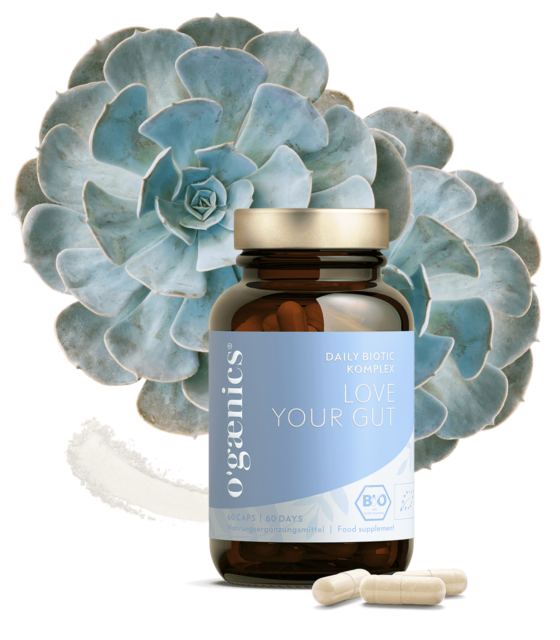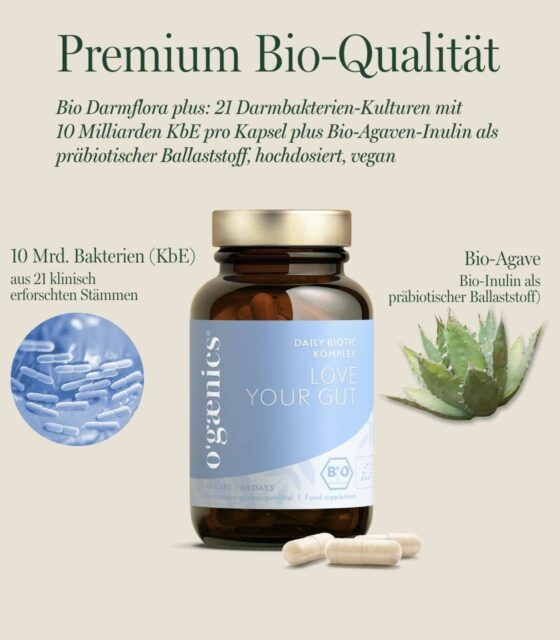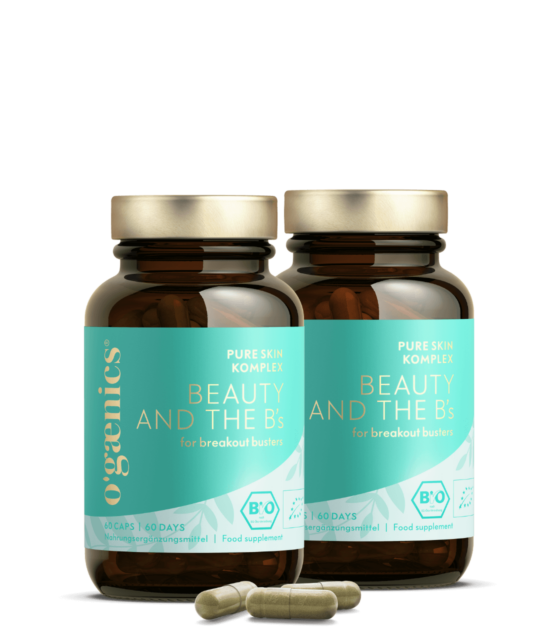Gut-skin axis: the science behind the bacteria that keep our skin healthy.
Your whole body is surrounded by bacteria. The two largest organs, intestine and skin are particularly colonized here and are connected by the so-called intestine-skin axis. In the right balance, these bacteria can boost your health. But when the balance is disturbed, skin problems are often the result. We’ll explain the connections and what you can do to improve your skin health.
The gut microbiome
Your digestive tract is home to billions of bacteria and other microorganisms. In the intestine, these bacteria are important for the digestion of food, the production of vitamins, the regulation of hormones, the elimination of toxins and much more. Your immune status, stress resistance, sleep, mood, behavior, metabolism, weight, hormones, and skin health all depend on the health of your gut.
The skin microbiome
By the skin microbiome we mean the bacterial ecosystem that covers our skin and protects us. The largest organ in our body is home to over 10 billion bacteria. After the intestine, the human skin thus contains the second highest number and diversity of microorganisms.
As the body’s first line of defense, the skin forms a physical and chemical barrier against the invasion of foreign substances or microorganisms. And it has an immune system that helps fight off infections. This is only possible with the right mixture of bacteria in balance. If there is an imbalance, skin problems are imminent.
What is the gut-skin axis?
The connection between our gut and skin microbiome is so close that the skin can be called the “mirror of the gut” – it shows how healthy we are inside. Studies have shown that an imbalance of gut bacteria can lead to skin problems, such as inflammatory conditions like dermatitis and acne.
Within the gut-skin axis, the gut and skin microbiomes work together and influence each other. Because both are directly connected through our immune system. Gut bacteria send messages via the immune system to your brain, which can use this information to influence not only moods and emotions, but also the texture and appearance of your skin.
Research also suggests that gut bacteria can also directly affect the skin. If the intestinal barrier is disturbed, intestinal bacteria and their metabolites can enter the bloodstream, accumulate in the skin and thus disrupt the skin’s microbiome. This then inevitably leads to skin problems.
This interaction between the intestine and the skin is therefore also referred to as the intestine-skin axis.
How can I improve my skin microbiome?
Now that you’ve learned that skin and gut communicate via the gut-skin axis, basically start in the gut to improve your skin microbiome.
Avoid negative triggers
What your intestines don’t like: too much stress and the wrong diet with too much sugar, cow’s milk products and unhealthy fats. These influencing factors can throw your gut microbiome out of balance, leading to skin problems via the gut-skin axis. Also avoid medications such as antibiotics unless they are absolutely vital. Try to avoid such triggers for intestinal and skin problems as much as possible.
Conscious diet with plenty of fiber
A conscious diet with sufficient fiber, vitamins and proteins is good for your skin health and also for the intestines. Dietary fiber undergoes a process of bacterial fermentation in the gastrointestinal tract, producing short-chain fatty acids that promote a healthy colon and skin. Studies have shown that a higher intake of dietary fiber is associated with a greater diversity of good gut microbes. And this is important for skin problems.
The recommended daily intake of dietary fiber is 30 g per day. In Germany, however, we only consume about 22 g per day. Therefore, be sure to increase the amount of fiber in your diet. Good sources of fiber are
- Chia seeds
- Flaxseed
- Beans and legumes
- Whole grains
- Vegetables
- Nuts and seeds
Probiotic food
Eating probiotic foods is also a great way to ensure you’re consuming a wide variety of beneficial strains that promote skin health and maintain a healthy gut microbiome. Try to eat one serving of the following foods daily to help manage your skin problems:
- Sauerkraut
- Kimchi
- Kefir
- Miso
- Tempeh
- Kombucha
- Natural yogurt
Prebiotic foods
Eating prebiotic foods also helps to maintain a healthy balance of the gut microbiome, and thus has a positive effect on skin problems. But beware: although all prebiotics are fiber, not all fiber is prebiotic.
Prebiotics are carbohydrates that are indigestible for humans. They serve as food for the beneficial bacteria so that they can thrive in the intestine and perform their health-promoting tasks. The most important prebiotics include oligofructose, inulin and resistant starch. You can find these valuable substances especially in
- Root vegetables such as Jerusalem artichokes, carrots, parsnips
- Chicory, artichokes, asparagus, tomatoes
- Bananas
- bulbous plants such as leeks, onions, garlic.
- Legumes
- Cereals (rye, barley, oats)
Synbiotics
If your intestinal flora is already noticeably out of balance (you will notice this in digestive problems of all kinds), a synbiotic such as the Love Your Gut Daily Biotic Complex is right for you. It can support your intestinal flora quickly and specifically with its superior formula of 10 billion microorganisms from 21 strains of bacteria combined with the prebiotic inulin.
These probiotics help with skin problems
Certain probiotics have been particularly effective in studies of people with skin problems. In a study with 80 participants, three highly effective bacterial strains were tested: Lactobacillus plantarum PBS067, Lactobacillus reuteri PBS072 and Lactobacillus rhamnosus LRH020.
Participants in the study were men and women between the ages of 18 and 50 with mild to moderate acne. While half of the participants took the three bacterial strains over a period of eight weeks, the other half received a placebo treatment. Both groups additionally use the same active cosmetics. The outcome of the subjects with the probiotic strains versus the placebo group:
- Normalization of the pH of the skin
- Reduced sebum production
- Increase skin hydration
- Reduction of the inflammatory status of the affected skin areas
- More even skin texture
We were thrilled and grabbed the three bacterial strains right away. In our Beauty and the Bs Skin Complex, we use the bacterial strains from the study in their clinically effective dosage. We have also supplemented it with the plant power of chlorophyll-containing organic barley grass and a regenerating plant-based organic vitamin B complex. Concentrated power for fewer skin problems in just 8 weeks.
Conclusion
The skin is one of our largest organs and always the first thing people see of us. So it’s no wonder that when it comes to skin problems, we want nothing more than beautiful and healthy skin. To get a little closer to this desire, it is important to understand how your body works.
Basically, in the fight against pimples, we must be patient. Careful treatment of our body is the be-all and end-all on the way to clear skin. A healthy gut is the first step.
If you want to learn more about gut health, probiotics and the microbiome, read on here:
- How menopause affects your gut health
- Optimize your gut health with synbiotics
- The crucial role of the microbiome for gut health
- Irritable bowel syndrome: Vitamin D can banish flatulence
- How the microbiome influences our health and ageing
- Bloated belly while traveling: how to prevent it
- What you should look for in a probiotic
- What can I expect when I take probiotics?
-
Bestseller
Love Your Gut
Bio Daily Biotic Complex Premium for the gut: 21 bacterial strains plus organic fiberab 29,90 €
Gut-skin axis
Arck, Petra, et al, Is there a `gut-brain-axis? Experiment dermatology 19.5 (2010).
Salem, Iman et al. “The Gut Microbiome as a Major Regulator of the Gut-Skin Axis.” Frontiers in microbiology vol. 9 1459. 10 Jul. 2018
Bowel and skin problems
Bowe, W.P., Logan, A.C. Acne vulgaris, probiotics and the gut-brain-skin axis – back to the future? Gut Pathog 3, 1 (2011).
Yan, Hui-Min, et al, Gut microbiota alterations in moderate to severe acne vulgaris patiets. The Journal of dermatology 45.10 (2018).
Zhang, Hong et al. Risk factors for sebaceous gland diseases and their relationship to gastrointestinal dysfunction in Han adolescents. The Journal of dermatology vol. 35,9 (2008): 555-61.
Marchetti, F et al. Efficacia dei regolatori della flora batterica intestinale nella terapia dell’acne volgare [Efficacy of regulators of the intestinal bacterial flora in the therapy of acne vulgaris]. La Clinica terapeutica vol. 122,5 (1987): 339-43.
Isolauri, E et al. Probiotics in the management of atopic eczema. Clinical and experimental allergy: journal of the British Society for Allergy and Clinical Immunology vol. 30,11 (2000): 1604-10.
Del Piano, Mario et al. “The use of probiotics in healthy volunteers with evacuation disorders and hard stools: a double-blind, randomized, placebo-controlled study.” Journal of clinical gastroenterology vol. 44 Suppl 1 (2010): S30-4
Manzotti G. et al. Probiotics as a Novel Adjuvant Approach to AtopicDermatitis. Journal of Contemporary Immunology (2014) Vol. 1 No. 2 pp. 57-66.
Study on the strains included in Beauty and the B’s in clinical dosage:
Michelotti, Angela et al. “Efficacy of a probiotic supplement in patients with atopic dermatitis: a randomized, double-blind, placebo-controlled clinical trial.” European journal of dermatology : EJD vol. 31,2 (2021): 225-232.










 No products in the cart.
No products in the cart.